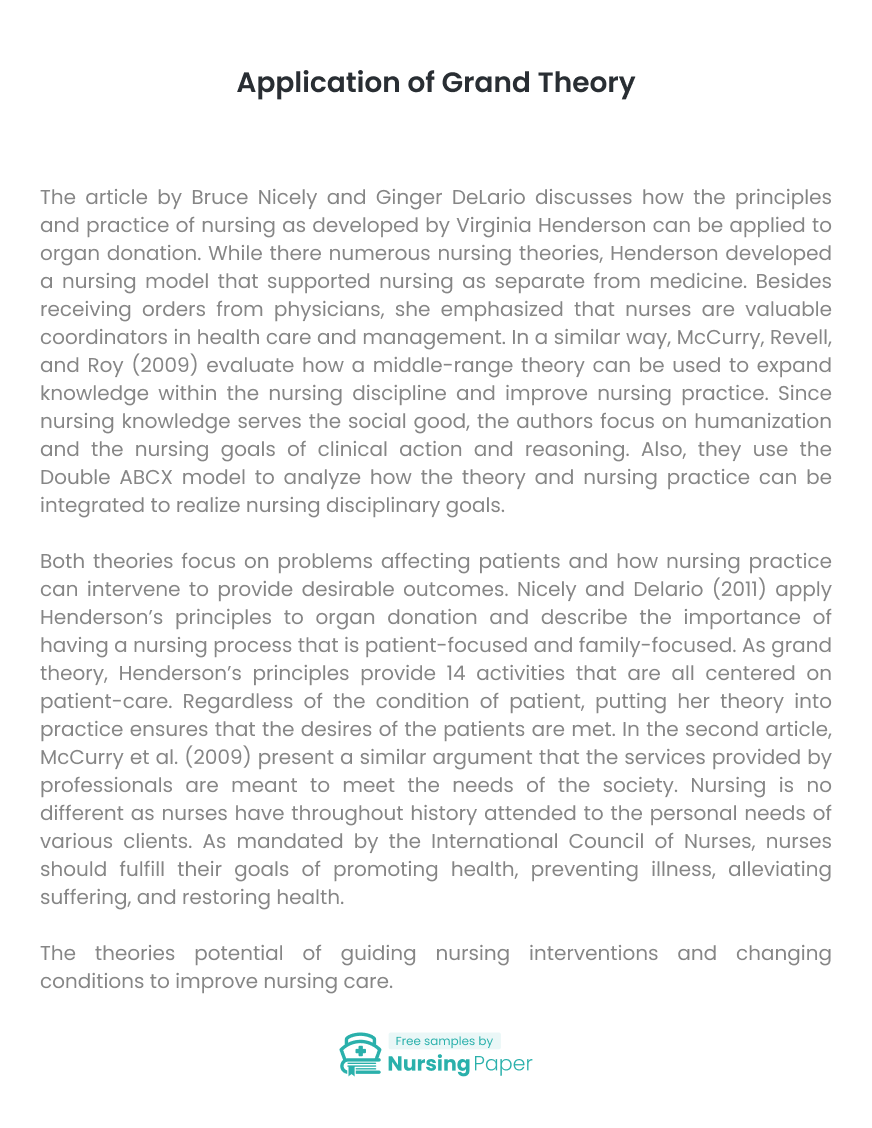
Application of Grand Theory
Part 1
The article by Bruce Nicely and Ginger DeLario discusses how the principles and practice of nursing as developed by Virginia Henderson can be applied to organ donation. While there numerous nursing theories, Henderson developed a nursing model that supported nursing as separate from medicine. Besides receiving orders from physicians, she emphasized that nurses are valuable coordinators in health care and management. In a similar way, McCurry, Revell, and Roy (2009) evaluate how a middle-range theory can be used to expand knowledge within the nursing discipline and improve nursing practice. Since nursing knowledge serves the social good, the authors focus on humanization and the nursing goals of clinical action and reasoning. Also, they use the Double ABCX model to analyze how the theory and nursing practice can be integrated to realize nursing disciplinary goals.
Both theories focus on problems affecting patients and how nursing practice can intervene to provide desirable outcomes. Nicely and Delario (2011) apply Henderson’s principles to organ donation and describe the importance of having a nursing process that is patient-focused and family-focused. As grand theory, Henderson’s principles provide 14 activities that are all centered on patient-care. Regardless of the condition of patient, putting her theory into practice ensures that the desires of the patients are met. In the second article, McCurry et al. (2009) present a similar argument that the services provided by professionals are meant to meet the needs of the society. Nursing is no different as nurses have throughout history attended to the personal needs of various clients. As mandated by the International Council of Nurses, nurses should fulfill their goals of promoting health, preventing illness, alleviating suffering, and restoring health.


Part 2
The theories potential of guiding nursing interventions and changing conditions to improve nursing care. McCurry et al. (2009) offer insights about how the Double ABCX model can be used to assess communities. In drawing their conclusions, the authors elucidate that model is suitable for identifying gaps and resources needed in healthcare. Moreover, some basic health care needs can be met and causes of illness addressed via the model. As for the grand theory, Nice and Delario (2011) stress that Henderson’s concept and principle of nursing contributes significantly to health care. In the case of the donation process, nurses that apply the principles are on the path to providing excellent care.
Although the two theories are comparable, there is a notable difference as detailed in the articles. The grand theory attempts to explain a broad area while the other depicts a set of related ideas. In the first article, Nice and Delario (2011) focus on the entire process and activities surrounding organ donation following brain death. Ranging from normal breathing to worshiping, the authors describe Henderson’s activities of assisting clients as they apply to the complex of donating and transplanting organs. It is an excellent framework that can be applied in the broader nursing metaparadigm to enhance the competencies of nurses. In contrast, McCurry et al. (2009) provide relatable ideas and variables. They acknowledge that the nursing profession has its bases on philosophy, theory, disciplinary goals, and practice. The variables form the framework for practice that serves the needs of the society and individuals.
1. Nicely, B., & Delario, G. (2011). Virginia Hendersons principles and practice of nursing applied to organ donation after brain death. Progress in Transplantation, 21(1), 72-77. doi:10.7182/prtr.21.1.c7617103jug3466m
2. McCurry, M. K., Revell, S. M., & Roy, S. C. (2009). Knowledge for the good of the individual and society: linking philosophy, disciplinary goals, theory, and practice. Nursing Philosophy, 11(1), 42-52. doi:10.1111/j.1466-769x.2009.00423.x



The download will start shortly.

The download will start shortly.
 Subject:
Health and Social Care
Subject:
Health and Social Care  Number of pages: 5
Number of pages: 5  Subject:
Nursing
Subject:
Nursing  Number of pages: 5
Number of pages: 5  Subject:
Medicine
Subject:
Medicine  Number of pages: 4
Number of pages: 4  Subject:
Nursing
Subject:
Nursing  Number of pages: 5
Number of pages: 5  Subject:
Medicine
Subject:
Medicine  Number of pages: 2
Number of pages: 2  Subject:
Health and Social Care
Subject:
Health and Social Care  Number of pages: 6
Number of pages: 6  Subject:
Nursing
Subject:
Nursing  Number of pages: 16
Number of pages: 16  Subject:
Nursing
Subject:
Nursing  Number of pages: 2
Number of pages: 2  Subject:
Health and Social Care
Subject:
Health and Social Care  Number of pages: 12
Number of pages: 12  Subject:
Nursing
Subject:
Nursing  Number of pages: 4
Number of pages: 4  Subject:
Nursing
Subject:
Nursing  Number of pages: 2
Number of pages: 2  Subject:
Nursing
Subject:
Nursing  Number of pages: 3
Number of pages: 3  Subject:
Health and Social Care
Subject:
Health and Social Care  Number of pages: 3
Number of pages: 3  Subject:
Nursing
Subject:
Nursing  Number of pages: 3
Number of pages: 3  Subject:
Medicine
Subject:
Medicine  Number of pages: 9
Number of pages: 9 
